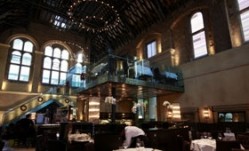How to turn a single outlet into a chain: Design

While you may be content with the design of your inaugural site, there are always improvements than can be made when you decide to roll the concept out. But if you don’t get the design and branding on your second or even third site perfect, you’re in trouble of damaging your business.
“The design of your second unit needs to be 80 per cent right,” says Adam Zombory-Moldovan, fonder of architect company ZMMA that has worked with Feng Sushi, Thistle Victoria Hotel and Christopher’s Bar and Grill in the past. “If you’re still wavering on what your look and feel is on your second unit then you haven’t got your head around what the identity of your brand is.
“By the time you reach your third, that’s when you should have ironed out the look, feel, atmosphere, operational requirements and budget.”
Understand your success and failures
The easiest way to ensure you have the design and branding right on your second unit is to understand the successes and failures of your existing site. Realise what design elements you like and that work with the requirements of your site, while identifying which ones make operations harder or contradict your brand message.
Huw Gott, co-founder of the Underdog Group, is due to open his second British steakhouse concept Hawksmoor in Covent Garden in September, but admits he and partner Will Beckett got the restaurant’s branding wrong to begin with.
“Our interior has been okay but not fantastic, so doing a second site has given us the opportunity to relook at all that stuff.
“Up till now we’ve never hired an interior or graphic designer and have made loads of mistakes along the way. We want to avoid some mistakes we made before and get it looking the way we want it to from day one.”
Gott and Beckett are eager to retain the original, historical features of their second Hawksmoor site, which will be situated in the basement of the Old Watney Combe Brewery, which features a vaulted brick ceiling with Victorian cast iron columns.
Indivuduality vs assmebly line
Tom Byng, founder of burger chain Byron, which is due to open its eleventh site at One New Change near St. Paul’s in October, agrees that while each site should convey the essence of the brand, each should retain some individuality.
“We have brand coherency throughout our sites, but you need to have individual elements. The restaurants need to feel like Byron but they need to feel like they have freshness and individuality too.
“What guides us is the local environment, and the building itself; if it has history and some original features then we like to be sympathetic to it. You have to think about designing your sites individually because brands evolve and areas differ.”
However, Zombory-Moldovan warns operators to be careful if they venture down the individually-designed outlet route.
“If you are rolling out an enterprise where you want each unit to look unique then at the heart of that there needs to be a consistent bit of thinking about what each unit is communicating about the brand.”
He suggests operators use a particular design element, be it a colour or item of furniture that communicates the brand identity, and carry that across each site.
“You want your customers to recognise and understand your brand straightaway,” he adds.
Communication and clarity
The most important thing to bear in mind when working with a designer is to always retain clarity about what your brand is and stands for, and communicate it clearly. Understand what your offer is, what kind of atmosphere you want to create and how that will appeal to your target market, and what your unique selling point is.
You’ll need to express all this through the design of your company logo and interiors, and ensure that you get it right second time around. Rolling out your concept from then on in should be a smoother and simpler process.
Read more articles in this series here.






























